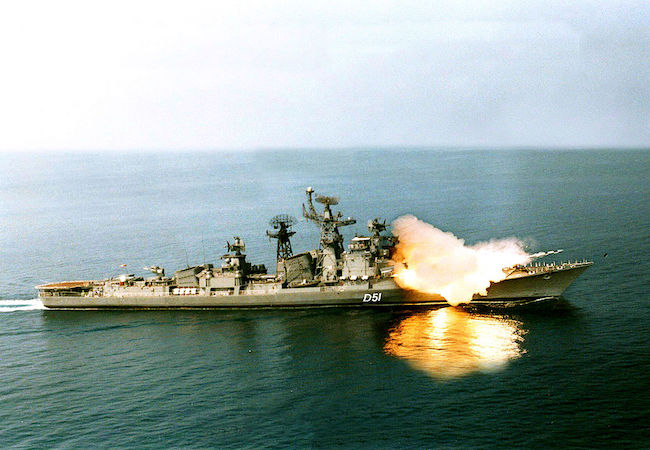
By Asma Khalid
India has instituted the strategy of Military modernization of its forces to achieve the geo-strategic objectives. In this regard India Navy is considered as central force to full fill the strategic goals of India; to emerge as a major global Player. Traditionally, Indian navy remained Cinderella service due to Nehruvian continental mindset but now “Modernizing and Growing” are two significant elements to describe India Navy. Three significant arrangement are key drivers of Indian naval modernization: one is prevent the country’s coastline and expensive maritime area of economic interest, second is to full fill desired regional and global ambitions and third is protect sea lines that deals with India’s supplies and trade. To achieve these goals Indian Navy has adopted more offensive and assertive doctrine based on ‘sea power framework’ of Alfred Mahan.
India Naval strategy of 2004 is comprised of six significant principles; increasing spending, modernization, expanding infrastructure, conducting naval exercises, deployment in Indian Ocean Region, active Maritime diplomacy and Protecting SLOC. Whereas Indian maritime doctrine of 2009 defines six striking roles in Indian Naval Forces, remarkable elements are deterrence, protecting sea lines decisive military victory and protection from threat. The Naval Doctrine highlights on the importance of enhance capabilities to influence warfare on land and development of forward power projection abilities. To achieve these objectives India’s defence spendings are increasing. 4.3% of total defence budget of 2016-2017 is allocated for Indian Navy: In total, 2921 billion was allocated to Navy which is around 17.4 per cent of total defence expenditure of India from 2005 to 2015 in nominal terms. It is significant to note that the annual growth rate of the Navy’s budget is around 15-18 per cent.
India is extensively modernizing its naval capacity, by acquiring a number of various modern vessels. Currently, Indian navy possesses quite an influx of manpower with an approximate total of 79,023 personnel and “a large fleet consisting of 2 aircraft carriers, 1GAH amphibious transport dock, 9 landing ship tanks, 14 frigates, 10 destroyers, 1 nuclear powered submarine and 14 conventionally powered submarines, 25 corvettes, 7 minesweeping vessels, 47 patrol vessels, 4 fleet tankers and various auxiliary vessels.” Though, the modernization is related more with enhancing the quality rather than the quantity; as it is replacing the older vessels with the advanced ones.
The qualitative and quantitative increase, doctrinal evolution and recent trends in the Indian Navy indicate that these development will posed various strategic implications on regional states and Indian Ocean region. Due to these trends region and Indian Ocean will experience new arrangement of strategic competition among regional states (India-Pakistan) and Great powers (U.S. and China). The strategic competition will increase the role of external powers in region and enhance the security dilemma in Ocean.
Secondly in recent era, Indo-Pacific Asia is very significant for trilateral regional competition: India-China, US-China and India-Pakistan. The bilateral rivalries among states are increasing the instability and disturbing the strategic equilibrium in region. Especially growing political and strategic partnership and Indo-U.S. nuclear deal is characterized as alliance to counter the emerging strategic partners: China and Pakistan. India is militarizing as well as nuclearizing the region to hold the chines claims regarding the ‘string of pearls’ strategy. India naval developments and aspiration to nuclearize its Navy are not as troublesome for china as for deterrence equation in South Asia. The South Asian security landscape is already unstable due to India-Pakistan historical rivalry. India naval build-up and modernization in conventional and nuclear sphere is increasing asymmetry between India and Pakistan. The conventional asymmetry and defence production gap between both states has made Pakistan to adopt the doctrine of full-spectrum deterrence to ensure its security and the launch of Indian nuclear powered submarine this rivalry has entered in other regions such as in the Indian Ocean.
With changing regional scenarios and prevailing challenges, the South Asia Strategic balance and security is threatened by the India’s naval modernization plan. Militarization and Nuclearization of Indian naval forces has increased the Indian deterrence capability but disturbed the balance of power of region by instigating the security dilemma and increasing the arms race.
India’s Proactive strategies, renewed defense settlements and the military build-up force the Pakistan to take counter measures while balancing the strategic equilibrium at the same time; for the Pakistan is important to closely track Indian defense spending and modernization plan, as India remains the key threat to Pakistan’s security.
Asma Khalid is Research Associate at Strategic Vision Institute (SVI), a think-tank based in Islamabad, Pakistan




